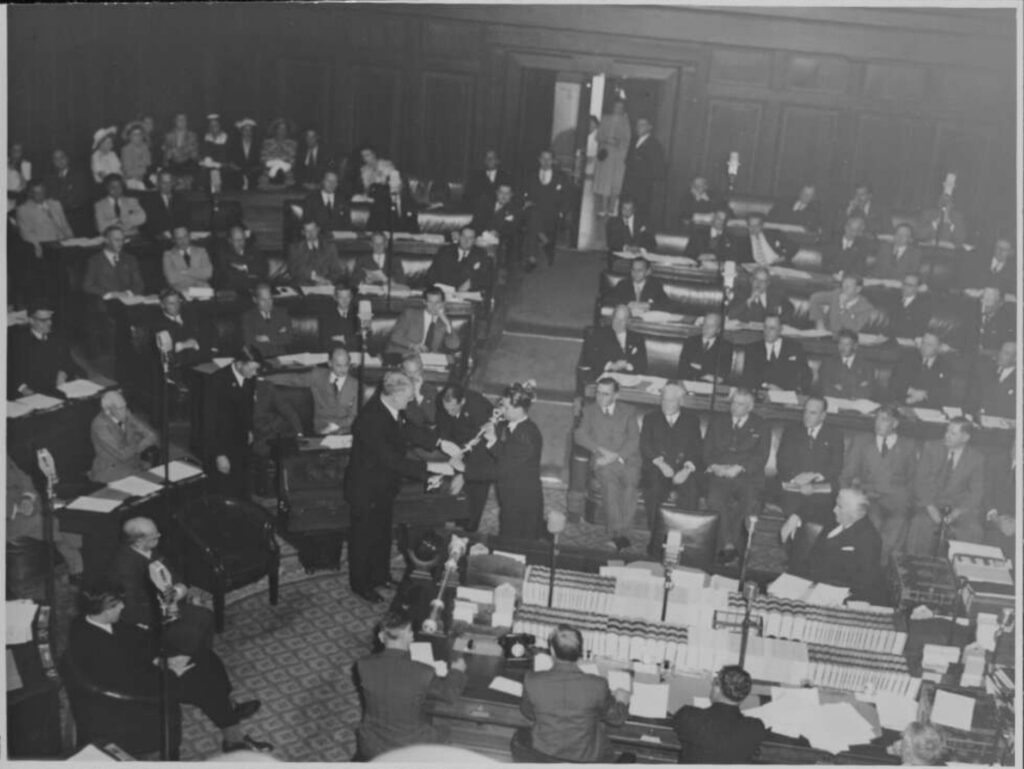On this day, 29 November 1951, the House of Representatives receives a new mace, a gift from the British Government to celebrate the Jubilee of Federation. The ornate object was made of solid silver and gold plating, weighed almost 8 kilograms, and had been crafted at the personal request of King George VI. It featured a crown as the embodiment of royal authority, emblems of each of Australia’s six states, and representations of wheat and fruit which stood for the agricultural bounty that was then central to Australia’s prosperity.
The mace was and is a great symbol of authority steeped in parliamentary tradition, but up until this point Australia had made do with a spare one, borrowed from the Victorian Parliament. While maces were originally weapons, their representative power can be traced back to medieval times, when the royal Serjeant-at-Arms carried a mace stamped with the Royal Arms, which gave them the authority to arrest a person without a written warrant in the monarch’s name. By 1415, the House of Commons had appointed its own Serjeant-at-Arms to serve the members of the House – a tradition which the Australian Parliament continues to uphold.
The mace has since become the symbol of the House’s power, as confirmed by the bloody battles of the English Civil War. Indeed, the current mace used by the British House of Commons was gifted by Charles II during the restoration of the monarchy, a demonstration that while the King had returned, he intended to uphold and respect the constitutional role of the Parliament.
In 1951, a delegation from the House of Commons presented the House of Representatives with the new mace, which was officially accepted by the Speaker – who serves as the head of the House such that ‘the authority of the Speaker and of the House are indivisible’.
However, the vote of thanks was moved by Prime Minister Menzies, who paid tribute to the deep historic roots of Australia’s parliamentary system which he felt were vital to its success:
‘I hope to be allowed to mention, with considerable brevity, three aspects of this historic occasion which present themselves clearly to the mind. The first of them is that this mace comes to us from Westminster. It comes to us from a Parliament which we call the Mother of Parliaments. It comes to us from a building in which there still stands, through all its battering, a hall – Westminster Hall – which is literally the cradle of the entire parliamentary institution. Anybody who had the imaginative ear of history and walked through Westminster Hall, past its smoke-stained walls, would hear the voices of debate in De Montfort’s parliament and would know that he was in the very spot, not only from which the British Parliament derives but from which every free parliament in the world derives. So, I should like to think that this mace comes to us from the great hall of William Rufus, with all the history and association that surround it.
Again, this mace has been borne here for us by members of all political parties in the House of Commons, and that fact, in itself, is a vivid reminder to us that every party division under our parliamentary system is conducted within the overall unity of the parliamentary idea itself. There is a genius about that conception, as it has worked itself out through the centuries, which, I believe, explains the durability of the idea of parliament, and also explains how so many hundreds of millions of people in the world, who are outside the tradition of our race, have seized upon this idea and found in it something which reconciles conflict with unity, and, therefore, enables a full national life to be lived. I hope that I shall be allowed to add, without making any invidious distinction, that every member of this House feels a little extra pleasure at receiving here, as the leader of this delegation, the son of Bonar Law. He is the son of a man who was one of the great men in the parliamentary tradition and one of the great parliamentary figures of this century. Finally, I mention, in my own way, an idea that has been touched on already. The mace began as the symbol of power. This mace lies on the table of this House, as the mace lies on the table of the House of Commons, not any longer as the symbol of power in an arbitrary sense, but as the symbol of a free parliament chosen by a free people making their laws freely and rendering to those laws a free and dignified obedience.’
The gifting of the mace was just a part of a wider celebration conducted throughout 1951 to commemorate 50 years since the inauguration of the Commonwealth. Other notable tributes included a midnight celebration that saw 150,000 people ring in the New Year in Melbourne, a ‘Cavalcade of Jubilee’ procession through the streets of Sydney on Australia Day, a ‘Miss Australia’ competition, a Jubilee Science Congress held in Brisbane, a cycling relay which collected 300,000 postcards and messages expressing loyalty and pride from around Australia and brought them to the Prime Minister in Canberra, a Wallabies vs All Blacks rugby match, a nation-wide theatre competition with a cash prize, a ‘Commonwealth Jubilee Big Game Fishing Championship’, a tour of Navy ships from all corners of the Commonwealth, commemorative newspaper pull-outs, the writing of original songs, and much more.
Sign up to our newsletter
Sign up for our monthly newsletter to hear the latest news and receive information about upcoming events.


